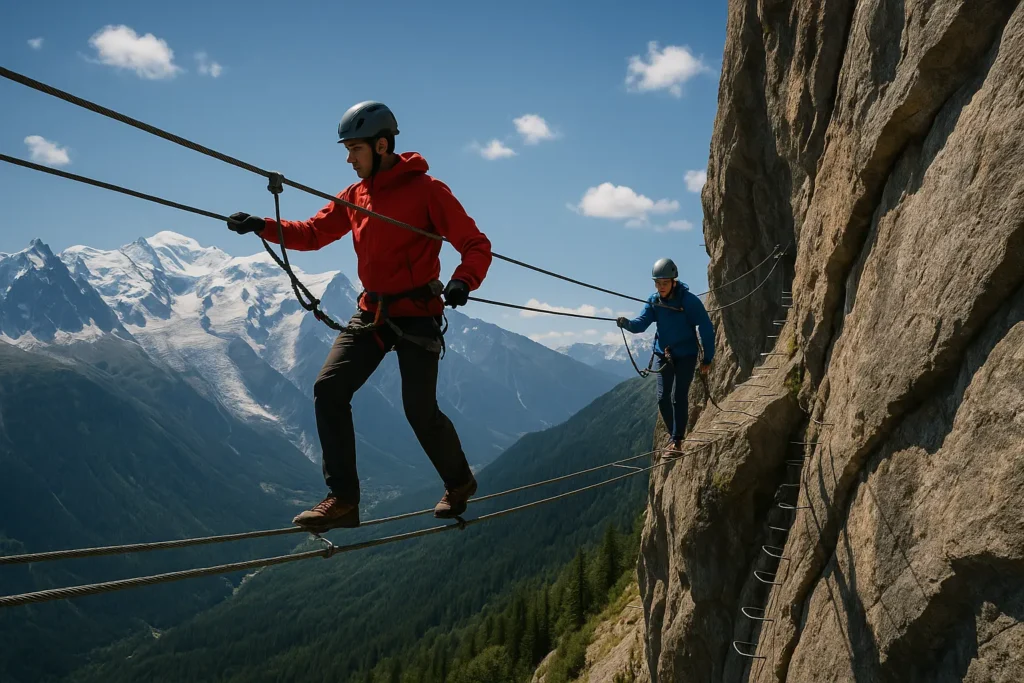Do you dream of an adventure between hiking and climbing but hesitate to take the plunge? Via ferrata in France blends thrills with safety, using equipped routes set in breathtaking landscapes from the Alps to the Pyrenees. Discover itineraries for everyone, from the family-friendly Capucin to the underground challenge of the Via Souterrata or the dizzying Roc du Vent. Whatever your level or expectations, get ready for an unforgettable experience: grand panoramas, guaranteed chills and full immersion in nature await on the country’s legendary walls.
Via ferrata in France: the adventure between hiking and climbing
Picture yourself ascending rock faces while admiring awe-inspiring views. Via ferrata in France offers this unique experience, combining the sensations of climbing with the freedom of hiking. Since the 1990s, the activity has won over nature and adrenaline lovers, becoming a staple of mountain sports.
A via ferrata involves following rock routes equipped with metal features. These installations ensure safety and accessibility for all, from beginners to advanced. Routes are fitted with safety cables, rungs fixed to the rock and suspended footbridges that test your balance. This clever engineering turns a vertical cliff into a secure aerial path.
French via ferrata routes use various technical elements for an optimal experience:
Safety cables (lifeline): run along the route to keep you permanently attached.
Rungs and rails: serve as handholds and footholds for vertical progress.
Monkey bridges and footbridges: allow you to cross gaps or voids for added thrills.
In France, more than 150 routes wind through the Alpine, Pyrenean and Auvergne ranges. Each offers a challenge suited to your level: family outings like Mont-Dore or Llo, and demanding itineraries such as Roc du Vent or Dévoluy. Children from age 10, supervised by professionals, can take part thanks to accessible layouts. The equipment (harness, lanyard, helmet) and graded difficulties make it an activity for everyone, regardless of age or experience.
Preparing your outing: essential kit and safety rules
Via ferrata is both fun and demanding, and requires careful preparation. Although some routes are possible from age 10, it remains a mountain sport that needs proper equipment to guarantee your safety. Why risk compromising an unforgettable experience by neglecting critical items?
Helmet: protects against falling debris. Choose a light, well-fitting model.
Harness: distributes forces in case of a fall. It must be comfortable and fit your body shape.
Energy-absorbing lanyard: Y-shaped system with two carabiners so you are always clipped in.
Gloves: reduce blisters and improve grip on potentially slippery cables.
Approach shoes: favour a stiff sole and good traction to climb on rock.
The basic rules seem simple, but following them is vital. Never unclip both carabiners at the same time, this rule saves lives. Only one person should occupy the space between two anchor points. If the weather turns, postpone the outing. Cables conduct electricity during storms and become slippery in rain.
Choose your route with common sense. F or PD routes, like Le Capucin in the Puy-de-Dôme, suit novices and feature Nepalese bridges. AD routes, such as Les Échelles de la Mort in the Gorges du Doubs, require good fitness. D+ routes, including Roc du Vent in the Beaufortain, may feature 40-metre zip lines. The “Aventure” rating is for experienced climbers, with higher weather exposure and fewer fixed aids.
Our pick of the finest via ferrata routes in France
Via ferrata in France boomed from the 1990s. This activity, blending the sensations of climbing with the freedom of hiking, grew thanks to purpose-built installations on rock faces. Full kit (harness, lanyard, helmet) keeps it accessible while preserving its adventurous spirit.
Legendary Alpine routes
The French Alps are home to emblematic via ferrata routes. They offer varied itineraries that mix technical difficulty with outstanding scenery. Modern installations ensure safety and accessibility.
Roc du Vent in Savoie targets fans of big elevation. This difficult route includes a Nepalese bridge and a 100-metre tunnel, with views of Mont Blanc and the surrounding ranges. The descent features technical sections such as a canyon and a chimney.
Le Diable in Savoie is the longest via ferrata in France. Its 3,760 metres and seven distinct sections deliver 900 metres of elevation gain. Climbers can link routes for anything from 30 minutes to 12 hours of activity.
Lacs Robert in Isère provide a high-mountain setting for the sport. Accessible by gondola, its progressive grading attracts both novices and experienced climbers. The views over the lakes are stunning, with footbridges and monkey bridges above the void.
Unique experiences in other massifs
Beyond the Alps, other French regions offer original via ferrata. These routes showcase the diversity available to fans of unusual mountain adventures.
La Via Souterrata in the Dévoluy (Hautes-Alpes) delivers a unique immersion. Its 300-metre route inside a cave creates an exceptional atmosphere. Specific kit is needed, including a headlamp and warm clothing, for this fully underground adventure.
Le Capucin in the Massif Central (Puy-de-Dôme) is ideal for a first family experience. Its moderate level and views over the Puy de Sancy make it a classic. Free access and a duration of around 1 hr 30 add to its appeal.
The Via Ferrata of Llo in the Pyrénées-Orientales proposes three routes for all levels. From easy to difficult, everyone can find joy here in an unspoilt mountain setting. Children from age 5 can access certain sections.
Les Échelles de la Mort in the Doubs tell a story linked to 18th-century smugglers. These metal ladders set above the Gorges du Doubs offer spectacular views. The activity remains safe if instructions are followed.
Comparison table of iconic routes
| Name of via | Range / Region | Difficulty | Approx. duration | Notable feature |
|---|---|---|---|---|
| Le Diable | Alps (Savoie) | 7 sections (PD to TD) | 8 h to 12 h (full) | Longest in France |
| Roc du Vent | Alps (Savoie) | D (Difficult) | 4 h to 5 h | Mont Blanc panorama, Nepalese bridge |
| La Via Souterrata | Alps (Dévoluy) | Easy | 1 h 30 | 100% underground cave route |
| Le Capucin | Massif Central (Puy-de-Dôme) | PD (Slightly Difficult) | 1 h 30 | Ideal for beginners and families |
| Via Ferrata de Llo | Pyrenees | F to D+ | 1 h to 3 h | Three routes for all levels |
| Les Échelles de la Mort | Jura (Doubs) | Moderate | Variable | Historic route in the gorges |
France’s via ferrata network showcases the creativity of route builders adapting rock faces to this hybrid activity. From the Alps to the Pyrenees, via the Jura and the Massif Central, each region offers unique routes. Modern installations ensure safety and accessibility without sacrificing the thrill of adventure.
Planning your via ferrata trip: practical advice
Finding the right route: tools and grades
Hundreds of via ferrata dot France. To choose, use interactive maps filtered by difficulty, region or features. Franceviaferrata.fr provides a detailed map with photos, videos and up-to-date topos. Always check whether the route is open before setting off.
Platforms also show difficulty levels (F to ED) and technical characteristics. Consult recent topos: ViaFerrata-FR.net compiles feedback and recent photos for itineraries such as the Rocher du Cornillon or Lac de Vouglans. For example, the Llo via ferrata offers options for every level, from the Llisses del Mouli for children aged 5 and up. For families, the Capucin via ferrata (Puy-de-Dôme) is ideal thanks to its very moderate difficulty and views of the Puy de Sancy. Challenge seekers will prefer the Via du Diable in Aussois, the longest in the world at 3,730 metres, between cliffs and historic fortifications.
Reaching sites without a car: a viable option
Getting to a site without a car is entirely feasible. In the Alps or the Pyrenees, many resorts are accessible by train. Local shuttles or buses complete the journey. This approach supports an eco-friendly sports trip and a memorable adventure. For instance, the Lac Robert via ferrata in Chamrousse is reachable by gondola or a marked trail.
Destinations such as Aussois (Savoie) or Prads-Haute-Bléone (Alps) offer rail links via TER or TGV. Some stations even provide seasonal shuttles or bike hire. For groups, bus networks to Les 3 Vallées streamline car-free travel. The free-access Falaise de Meichira via ferrata at Prads-Haute-Bléone illustrates this approach well. By combining train and local transport, you gain peace of mind while fully enjoying mountain scenery.
Ready to step onto France’s walls?
Via ferrata in France embodies an adventure at the crossroads of hiking and climbing, accessible to all as long as basic safety is respected. Alpine or Jura landscapes provide unforgettable panoramas, but success hinges on picking a route suited to your level. Whether you are a beginner or advanced, this activity blends adrenaline with discovery of nature.
Check the local weather: mountain conditions are unpredictable. Avoid storms, as cables are dangerous in lightning and slippery in rain.
Tell someone your plan: note your route and estimated return time. An app can share your location.
Bring water and snacks: hydration and energy are vital for muscular effort.
Charge your phone: a working device is crucial if something unexpected happens.
Before you set off, remember to hydrate. Why not pick the right sports bottle? It will be your ally for maintaining energy throughout the activity. With these preparations, every via ferrata becomes a shared moment and a successful challenge.
Via ferrata in France unites adventure and nature, offering challenges tailored to everyone, from beginners to seasoned climbers. By respecting safety guidance, choosing your route and packing a suitable sports bottle, each outing becomes an unforgettable adventure. Clip in and go.






